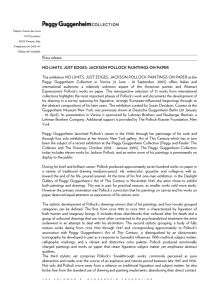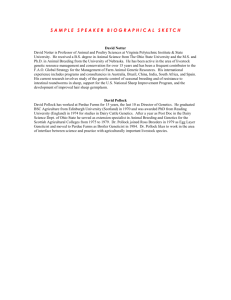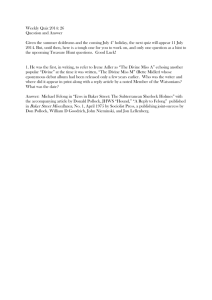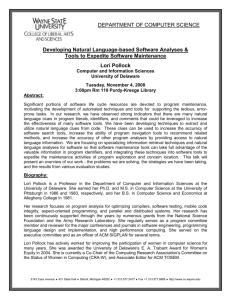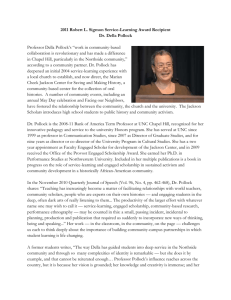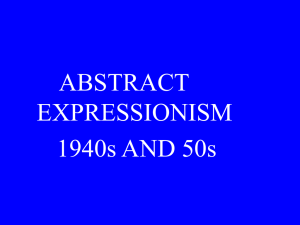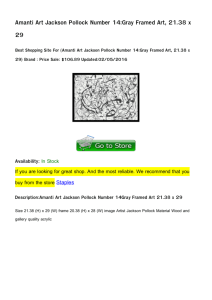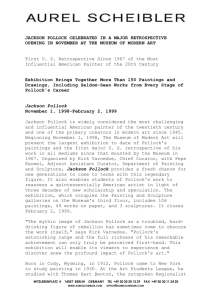Robert Mapplethorpe und die klassische Tradition
advertisement
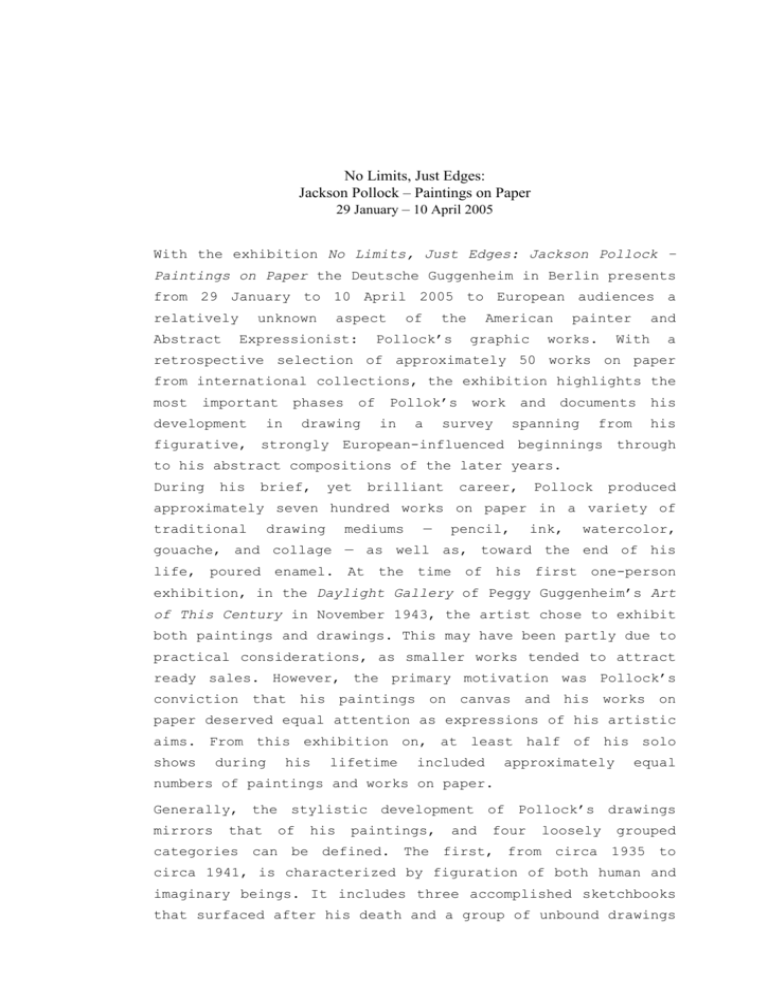
No Limits, Just Edges: Jackson Pollock – Paintings on Paper 29 January – 10 April 2005 With the exhibition No Limits, Just Edges: Jackson Pollock – Paintings on Paper the Deutsche Guggenheim in Berlin presents from 29 January to 10 April 2005 to European audiences a relatively Abstract unknown aspect Expressionist: of the Pollock’s American graphic painter works. and With a retrospective selection of approximately 50 works on paper from international collections, the exhibition highlights the most important development phases of Pollok’s work and documents his in drawing in a survey spanning from his figurative, strongly European-influenced beginnings through to his abstract compositions of the later years. During his brief, yet brilliant career, Pollock produced approximately seven hundred works on paper in a variety of traditional drawing mediums — pencil, ink, watercolor, gouache, and collage — as well as, toward the end of his life, poured enamel. At the time of his first one-person exhibition, in the Daylight Gallery of Peggy Guggenheim’s Art of This Century in November 1943, the artist chose to exhibit both paintings and drawings. This may have been partly due to practical considerations, as smaller works tended to attract ready sales. However, the primary motivation was Pollock’s conviction that his paintings on canvas and his works on paper deserved equal attention as expressions of his artistic aims. From this exhibition on, at least half of his solo shows during his lifetime included approximately equal numbers of paintings and works on paper. Generally, the stylistic development of Pollock’s drawings mirrors that of his paintings, and four loosely grouped categories can be defined. The first, from circa 1935 to circa 1941, is characterized by figuration of both human and imaginary beings. It includes three accomplished sketchbooks that surfaced after his death and a group of unbound drawings that are most often connected to the psychoanalytical treatment the artist underwent in an attempt to deal with his alcoholism. The second stylistic grouping, a body of fully mature works dating corresponding between approximately circa to 1942 Pollock’s through 1947 association and with Peggy Guggenheim’s museum/gallery Art of This Century, is distinguished by an idiosyncratic iconography he developed in part as a response to Surrealist influences. Employing mythical subject matter, calligraphic markings, and a vibrant and distinctive color palette, Pollock produced emotionally charged paintings and works on paper that retain figurative subject matter yet emphasize abstract qualities. Arising from this confluence of abstraction and figuration, the third stylistic set comprises Pollock’s breakthrough works, commonly perceived as pure abstraction and made over the course of a very explosive and intense period between late 1947 and 1950. Here, not only did Pollock move away from a reliance on traditional figuration and subject matter, but he also broke free from the standard use of drawing and painting implements, usually abandoning their direct contact with the surface. Instead, he worked from distances above the picture plane, techniques — using methods dripping, that were pouring, not and splattering necessarily Pollock’s invention alone but that he pushed to new extremes. The fourth and final group represents a further refinement of Pollock’s pouring techniques. Here the drawings are still stylistically related to his works on canvas of the time, but whereas earlier drawings had a clear connection to larger canvases, these later drawings are distinct explorations that specifically exploit the qualities of working with fluid mediums on porous paper. Like the canvas paintings completed between 1950 and 1952, these drawings exhibit a more open, light ground scattered with lyrical compositions of calligraphic forms. The last four years of Pollock’s life — he died tragically in an automobile accident on August 11, 1956 — are almost devoid of drawings; correspondingly, his output of paintings also diminished. No Limits, Just Edges: Jackson Pollock – Paintings on Paper was curated by Susan Davidson, Curator of the Guggenheim Museum New York. The exhibition is accompanied by a hardcover catalogue published in separate German and English editions. Featuring an essay by the curator alongside contributions by David Anfam and Margaret Holben Ellis, the catalogue is available for € 34. As Edition No. 30 Jackson Pollock’s Pens and Papers, 2005, was produced in a limited edition of 350 copies, thereof 50 copies as subscription edition. Exclusively available for purchase at the MuseumsShop, the standard edition is priced at € 85, and the subscription edition in a display case is priced at approx. € 240. No Limits, Just Edges: Jackson Pollock – Paintings on Paper is accompanied by an extensive supporting program. For the 17th Long Night of the Museums on 29 January 2005, the Deutsche Guggenheim will show the film portrait Pollock, USA 2000 at 8 p.m. and 11 p.m. in the atrium of the Deutsche Bank. The film traces the artistic development of the Abstract Expressionist from a biographical perspective. In relation to the Long Night’s thematic focus on Art Collecting, there are guided tours through the Deutsche Bank Collection located in the building Unter den Linden hourly from 6.30 – 11.30 p.m. The exhibition will remain open on the Long Night of Museums until 2 a.m. On 22 and 30 March 2005, Trio Nexus, Berlin, will perform music by the American composer Morton Feldman, who was a close friend of Pollock. Musically influenced by Edgar Varèse, Anton von Webern and John Cage, Feldman also derived inspiration from the abstract paintings of Philip Guston, Willem de Kooning, Jackson Pollock and Jasper Johns. On 22 March 2005 at 7 p.m., two pieces entitled Why Patterns? (1978) und Crippled Symmetry (1983) will be performed. A further piece, For Philip Guston (1984), can be heard on 30 March 2005 at 7 p.m. The exhibition will also be accompanied by a series of lectures exploring various aspects of Pollock’s oeuvre. On 24 February at 7 p.m., the visual artist and writer Olga Lewicka will give a lecture entitled Drip’n’Draw – Design and Concept in the Works drawings, of she Jackson will Pollock. explore the Focusing on Pollock’s relationship between spontaneity and theory. Jasper Sharp, Exhibition Organizer of the Peggy Guggenheim Collection in Venice, will concentrate in his lecture on 10 March at 7 p.m. on the special relationship between the collector and the artist. His talk will cast success light upon the factors underlying the enormous of Pollock’s first solo exhibition in Peggy Guggenheim’s gallery Art of this Century, as well as upon the reciprocal influence of the two on each other’s careers. Expert on modern American art and co-author of the exhibition catalogue, David Anfam, will explore the themes of Jackson Pollock’s work, especially its relationship to photography and American culture. Entitled Jackson Pollock: Action, Art and America, Anfam’s lecture will be held on 31 March at 7 p.m. A special focus of the supporting program is on the events offered to children and families. In addition to the traditional Family Brunch, which takes place at the Deutsche Guggenheim on Sunday, 27 February at 11:30 p.m., the museum will be running a special program for children between the age of three and twelve. On 6 and 13 February 2005 at 3 p.m., and on 5 and 6 April 2005 at 4 p.m., little art lovers will have the opportunity to explore the world of Jackson Pollock’s colors and lines. Free guided tours are offered daily at 6 p.m., and the well known Lunch Lectures on Wednesdays at 1 p.m. and keynote tours on Sundays at 11.30 a.m. will round off the support program as usual. Further information at: Press: Silvie Buschmann Phone: +49-30-202093-14 Fax: +49-30-202093-20 email: berlin.guggenheim@db.com Internet: www.deutsche-guggenheim.de Images of the exhibition are available files.de/guggenheim in 300 dpi resolution. online at www.photo-
